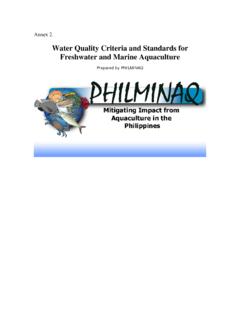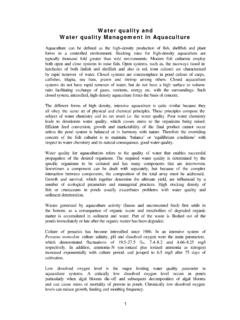Transcription of THE IMPORTANCE OF FISHERIES AND AQUACULTURE TO …
1 353 The IMPORTANCE of FISHERIES and AQUACULTURE to developmentAbstractSmall-scale FISHERIES and AQUACULTURE make criti-cal contributions to development in the areas of employment, with over 41 million people world-wide, the vast majority of whom live in devel-oping countries, working in fish production; food security and nutrition, with fish constituting an important source of nutrients for the poor and often being the cheapest form of animal prote-in; and trade, with a third of fishery commodity production in developing countries destined for most capture FISHERIES worldwide con-sidered fully exploited or overexploited, aquacul-ture will be central to meeting fish demand, which w il l continue to increase w ith popu lation grow th, rising incomes and increasing urbanisation.
2 As AQUACULTURE develops, however, governments will need to manage its potential ecological and social impacts. African AQUACULTURE , which has grown much more slowly than in other regions, faces numerous challenges, including resource conflicts and difficulties in accessing credit, quality seed and feed, and information. Also key to meeting growing demand will be improvements in post-harvest processing to reduce fish IMPORTANCE OF FISHERIES AND AQUACULTURE TO DEVELOPMENTC ambria FinegoldBoth FISHERIES and AQUACULTURE are often neg- lected in national development policy and donor priorities, as policy makers often do not have ac-cess to data which reflect the IMPORTANCE of fisher-ies and AQUACULTURE to development .
3 Appropriate policies and regulation remain important, how-ever, both in managing capture FISHERIES and en-suring that AQUACULTURE development is pro-poor and , AQUACULTURE and development introductionDespite the significant contributions that FISHERIES and AQUACULTURE make to employment, nutrition, and trade in the developing world, they are rare-ly included in national development policy and donor priorities. This is largely due to problems with valuation of small-scale FISHERIES , as policy makers often do not have access to data which re-flect the IMPORTANCE of FISHERIES and AQUACULTURE to stagnation or decline of capture fishery production in many parts of the world under- scores the IMPORTANCE of FISHERIES policy, how-ever, as the current state of stocks can be at least FISHERIES , SUSTAINABILITY AND DEVELOPMENT354partially attributed to the difficulties of regulating FISHERIES and preventing their overexploitation.
4 Even with improvements in regulation, how-ever, pressures on capture FISHERIES will remain, due to continued population growth. Further development of sustainable AQUACULTURE and im-provements in the post-harvest sector to reduce losses could help to maintain fish supply and the contribution of fish to , production and tradeWhile data on FISHERIES in developing countries are often patchy1, it is nevertheless possible to identify trends in the IMPORTANCE of FISHERIES and AQUACULTURE for developing countries, partic-ularly in the areas of employment, consump-tion, and in fishing and AQUACULTURE has grown rapidly over the past few decades.
5 In-creasing more than threefold from 13 mil-lion people in 1970 to over 41 million in 2004 (Figure 1). Employment in the FISHERIES sector has grown more rapidly than both world popu-lation and employment in agriculture. Most of this growth is in Asia, where over 85 percent of the world s fisherfolk live, and is largely due to the expansion of AQUACULTURE in this period (FAO 2006, FAO 1999).While the number of people employed in FISHERIES and AQUACULTURE in developing countries has been growing steadily, it has been stagnant or declining in most industrialised countries. This decline has been most pronounced in capture FISHERIES , while employment in AQUACULTURE has increased in some industrialised of women in developing countries are employed in FISHERIES and AQUACULTURE , par-ticipating at all stages in both commercial and artisanal FISHERIES , though most heavily in fish processing and marketing.
6 In capture FISHERIES , women are commonly involved in making and repairing nets, baskets and pots, baiting hooks, setting traps and nets, fishing from small boats 1. Though many countries collect data on commercial marine FISHERIES and on fish exports, catches by artisanal and part-time or occasional fisherfolk often go unrecorded. The status of inland FISHERIES is also much more difficult to assess than marine FISHERIES , as fishing is often practiced in remote locations by poor small-scale fishers who target a wide range of species using several types of gear, and whose catches are rarely disaggregated by species if recorded at all.
7 Data on FISHERIES in developing countries therefore often underestimate the numbers of people who depend on FISHERIES for their livelihoods and diets, and the actual contribution of FISHERIES to development is likely to be higher than is reflected in 1. Employment in FISHERIES and AQUACULTURE . Data for 1970, 1980 and 1990 are from FAO (1999), while data from 2000 and 2004 are from FAO (2006), and therefore may not be perfectly of peopleYear50403020100 AsiaOceaniaEuropeAfricaSouth AmericaNorth & Central America20042000199 0198 01970 355 The IMPORTANCE of FISHERIES and AQUACULTURE to developmentand canoes, and collecting seaweed, bivalves, molluscs and pearls.
8 They are rarely involved in commercial offshore and deep-water fishing. In AQUACULTURE , women feed and harvest fish, at-tend to fish ponds, and collect fingerlings and prawn larvae. Women play a major role in fish processing in many pa r ts of the world, both using traditional preservation methods and working in commercial processing addition to affecting food supply, the status of fish stocks in capture FISHERIES is likely to threat- en the livelihoods of small-scale fisherfolk and traditional fish processors as competition for lim-ited resources increases.
9 Larger-scale operators with greater access to capital and gear are already emerging in many areas, leading to changes in the structure and location of post-harvest activi-ties and concentrating ownership and control of resources. In India, for example, fishing practices are changing with rising investment, and higher levels of mechanisation and motorisation are leading to greater centralisation of landings and competition over the catch. In the past, small-scale traders were able to purchase fish from local fish-ers at decentralised beach-based landings, some- times accessing fish through husbands or taking the fish on credit and paying once they had sold it.
10 The increasing centralisation of landings, how-ever, has led to fierce competition at landing sites, favouring those with greater access to credit and infrastructure and marginalising traditional fish processors and petty traders (FAO 2007).Production and consumptionData on FISHERIES in developing countries often do not fully account for artisanal and subsistence production, as the magnitude of the landings of these FISHERIES is not generally known by the re-sponsible FISHERIES administration. It seems clear, however, that capture FISHERIES worldwide are currently being fished at or near capacity, and that further growth in fish production will come primarily from AQUACULTURE .




